


In fact, the differing reactions she and Raki have to what turn out to be similar situations are symptomatic of the entire series: when you're telling a story about people fighting monsters that eat people, trauma is to be expected, and every person reacts to their own story in very individual ways.Īnd, as the story progresses, the world that Norihiro is building just gets more complicated and more interesting. Admittedly, that human way is taciturn and closed-off, and mostly reflected in Raki's much more expressive mannerisms, but this just serves to make her a more interesting character. Clare has real trauma, that's hinted at in a quick flashback, and deals with it, and her developing relationship with Raki, in a very real human way. This isn't your average girls-fight-monsters story.


His gratitude to her when she saves him, combined with the village's distrust when they realise how close he was to the yoma, causes him to follow her out of the village and into her dangerous world, where a hesitant friendship develops between a boy who has lost everything and a girl who has shut herself off from the world. If it sounds familiar to you, you probably already know whether or not this series is for you.Ĭlare is a warrior that the Organization sends to a village for a routine yoma hunt, where she meets Raki, the young boy whose parents were the first victims. The warriors' inhumanity, clear in their lack of pigmentation in hair and skin and their shining silver eyes, makes it hard for humans to trust them, and leaves them outcasts in the society they work to protect. Half yoma themselves, these warriors have the strength and speed needed to fight yoma, and the ability to sense them out when they're hiding among humans. In a pre-industrial world in which monsters called yoma infiltrate human settlements in order to hunt and feed on human viscera, female warriors known as Claymores (after the huge swords they carry) are employed to hunt and kill the yoma.


 0 kommentar(er)
0 kommentar(er)
